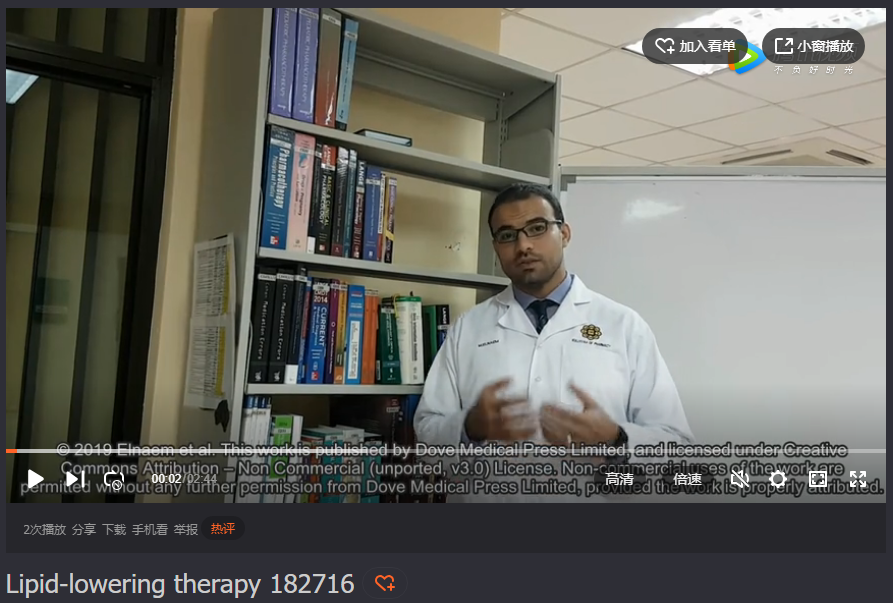9 0 8 0 2
论文已发表
注册即可获取德孚的最新动态
IF 收录期刊
- 2.6 Breast Cancer (Dove Med Press)
- 3.9 Clin Epidemiol
- 3.3 Cancer Manag Res
- 3.9 Infect Drug Resist
- 3.6 Clin Interv Aging
- 4.8 Drug Des Dev Ther
- 2.8 Int J Chronic Obstr
- 8.0 Int J Nanomed
- 2.3 Int J Women's Health
- 3.2 Neuropsych Dis Treat
- 4.0 OncoTargets Ther
- 2.2 Patient Prefer Adher
- 2.8 Ther Clin Risk Manag
- 2.7 J Pain Res
- 3.3 Diabet Metab Synd Ob
- 4.3 Psychol Res Behav Ma
- 3.4 Nat Sci Sleep
- 1.9 Pharmgenomics Pers Med
- 3.5 Risk Manag Healthc Policy
- 4.5 J Inflamm Res
- 2.3 Int J Gen Med
- 4.1 J Hepatocell Carcinoma
- 3.2 J Asthma Allergy
- 2.3 Clin Cosmet Investig Dermatol
- 3.3 J Multidiscip Healthc

Effectiveness and prescription pattern of lipid-lowering therapy and its associated factors among patients with type 2 diabetes mellitus in Malaysian primary care settings
Authors Elnaem MH, Nik Mohamed MH, Huri HZ, Mohd Shah AS
Received 5 August 2018
Accepted for publication 8 November 2018
Published 18 January 2019 Volume 2019:15 Pages 137—145
DOI https://doi.org/10.2147/TCRM.S182716
Checked for plagiarism Yes
Review by Single-blind
Peer reviewers approved by Dr Amy Norman
Peer reviewer comments 2
Editor who approved publication: Professor Garry Walsh
Background: Cardiovascular diseases (CVDs) are the
main complication leading to morbidity and mortality among patients with type 2
diabetes mellitus (T2DM). There is a large amount of evidence to support the
use of lipid-lowering therapy (LLT) for the prevention of CVD. This study aimed
to assess the effectiveness and prescription quality of LLT among T2DM patients
and to identify its associated factors.
Methods: A
multicenter cross-sectional study included 816 T2DM patients from four
different primary care centers in Pahang, Malaysia. We involved LLT-eligible
T2DM patients as per the national clinical practice guidelines (CPG). The
assessment of therapy effectiveness focused on the attainment of target lipid
measures stated in the CPG. Evaluation of the prescription quality was
classified into appropriate, potentially inappropriate, and inappropriate,
based on the compliance with guidelines and existence of potential safety
concerns. Binomial logistic regression was employed to identify the predictors
of LLT effectiveness and prescription quality.
Results: The
overall percentage of T2DM patients receiving statin therapy was 87.6%
(715/816). Statin therapy was appropriately prescribed in 71.5% of the cases.
About 17.5% of the LLT prescriptions have at least one significant drug
interaction with co-prescribed medications. The achievement of the primary
target of low-density lipoprotein cholesterol (LDL-C) levels was observed in
only 37% of T2DM patients. The LLT indication and appropriateness of
prescription were significantly associated with the attainment of LDL-C
treatment goals. Primary prevention, Malay race, and hypertension were
identified as predictors for appropriate prescribing of LLT among T2DM
subjects.
Conclusion: There
is a need to enhance the quality of LLT prescribing in the primary care setting
to cover all eligible high-risk patients and ensure patient safety. Strategies
to improve the achievement of LDL-C goals among patients with T2DM, such as
investigating the potential role of the combination therapy and high-intensity
statin therapy, are required.
Keywords: primary
care, statin therapy, diabetes, dyslipidemia, Malaysia
摘要视频链接:Effectiveness
and prescription pattern of lipid-lowering therapy
